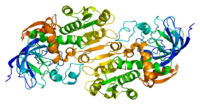
Photo from wikipedia
ATP dependent ParE enzyme is as an attractive target for the development of antibacterial agents. Atom based 3D-QSAR model AADHR.187 was developed based on the thirty eight Escherichia coli ParE… Click to show full abstract
ATP dependent ParE enzyme is as an attractive target for the development of antibacterial agents. Atom based 3D-QSAR model AADHR.187 was developed based on the thirty eight Escherichia coli ParE inhibitors. The generated model showed statistically significant coefficient of determinations for the training (R2 = 0.985) and test (R2 = 0.86) sets. The cross-validated correlation coefficient (q2) was 0.976. The utility of the generated model was validated by the enrichment study. The model was also validated with structurally diverse external test set of ten compounds. Contour plot analysis of the generated model unveiled the chemical features necessary for the E. coli ParE enzyme inhibition. Extra-precision docking result revealed that hydrogen bonding and ionic interactions play a major role in ParE protein-ligand binding. Binding free energy was computed for the data set inhibitors to validate the binding affinity. A 30-ns molecular dynamics simulation showed high stability and effective binding of inhibitor 34 within the active site of ParE enzyme. Using the best fitted model AADHR.187, pharmacophore-based high-throughput virtual screening was performed to identify virtual hits. Based on the above studies three new molecules are proposed as E. coli ParE inhibitors with high binding affinity and favourable ADME properties.
Journal Title: Computational biology and chemistry
Year Published: 2020
Link to full text (if available)
Share on Social Media: Sign Up to like & get
recommendations!